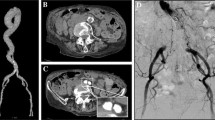Abstract
A 57-year-old male with end stage renal disease underwent coronary angiography (CAG). The CAG revealed two vessel disease with severe calcification. A week after the percutaneous coronary intervention (PCI) to the left anterior descending coronary artery (LAD), we performed PCI to the right coronary artery (RCA). Because of the calcification, no devices could be crossed. We then performed 5 in 7 method using Heartrail ST01, and inserted it across the stenosis, with dilatation balloon at the distal RCA as anchoring. Finally we managed to implant two stents. We report that 5 in 7 method and deep seating of 5 Fr. guiding catheter were effective for the severely calcified lesion.





Similar content being viewed by others
References
Ibels LS, Alfrey AC, Huffer WE, Craswell PW, Anderson JT, Weil R 3rd. Arterial calcification and pathology in uremic patients undergoing dialysis. Am J Med. 1979;66:790–6.
Maclsaac Al, Bass TA, Bunchbinder M, Cowley MJ, Leon MB, Warth DC, et al. High speed rotational atherectomy: outcome in calcified and non calcified coronary artery lesions. J Am Coll Cardiol. 1995;26:731–6.
Vijayvergiya R, Swamy AJ, Grover A. Buddy wire technique: a simple technique for treating calcified lesion: a case report. J Invasive Cardiol. 2006;18:E129–30.
Burzotta F, Trani C, Mazzari MA, Mongiardo R, Rebuzzi AG, Buffon A, et al. Use of a second buddy wire during percutaneous coronary interventions: a simple solution for some challenging situations. J Invasive Cardiol. 2005;17:171–4.
Kirtane AJ, Stone GW. The Anchor-Tornus technique: a novel approach to “uncrossable” chronic occlusions. Catheter Cardiovasc Interv. 2007;70:554–7.
Takeshita S, Shishido K, Sugitatsu K, Okamura N, Mizuno S, Yaginuma K, et al. In vitro and human studies of a 4F double-coaxial technique (“mother-child” configuration) to facilitate stent implantation in resistant coronary vessels. Circ Cardiovasc Interv. 2011;4:155–61.
Shaukat A, Al-Bustami M, Ong PJ. Chronic total occlusion—use of a 5 Fr guiding catheter in a 6 Fr guiding catheter. J Invasive Cardiol. 2008;20:317–8. http://www.ncbi.nlm.nih.gov/pubmed/18523329.
Author information
Authors and Affiliations
Corresponding author
Rights and permissions
About this article
Cite this article
Hoshino, Y., Kunii, H., Misaka, T. et al. Deep seating of 5 Fr. guiding catheter across the stenosis with 5 in 7 method was effective for severely calcified lesion. Cardiovasc Interv and Ther 28, 87–90 (2013). https://doi.org/10.1007/s12928-012-0119-y
Received:
Accepted:
Published:
Issue Date:
DOI: https://doi.org/10.1007/s12928-012-0119-y




